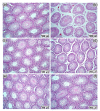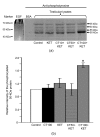Antioxidant activity and protective effect of Clitoria ternatea flower extract on testicular damage induced by ketoconazole in rats
- PMID: 24903992
- PMCID: PMC4116859
- DOI: 10.1631/jzus.B1300299
Antioxidant activity and protective effect of Clitoria ternatea flower extract on testicular damage induced by ketoconazole in rats
Abstract
Background: Ketoconazole (KET), an antifungal drug, has adverse effects on the male reproductive system. Pre-treatments with antioxidant plant against testicular damage induced by KET are required. The flowers of Clitoria ternatea (CT) are proven to have hepatoprotective potential. However, the protective effect on KET-induced testicular damage has not been reported.
Objective: To investigate the protective effect of CT flower extracts with antioxidant activity on male reproductive parameters including sperm concentration, serum testosterone level, histopathology of the testis, and testicular tyrosine phosphorylation levels in rats induced with KET.
Methods: The antioxidant activity of CT flower extracts was determined using 2,2-diphenyl-1-picrylhydrazyl (DPPH) and ferric reducing antioxidant power (FRAP) assays. Male rats were treated with CT flower extracts (10, 50, or 100 mg/kg BW) or distilled water via a gastric tube for 28 d (preventive period: Days 1-21) and induced by KET (100 mg/kg BW) via intraperitoneal injection for 7 d (induction period: Days 22-28). After the experiment, all animals were examined for the weights of the testis, epididymis plus vas deferens and seminal vesicle, serum testosterone levels, sperm concentration, histological structures and diameter of testis, and testicular tyrosine phosphorylation levels by immunoblotting.
Results: The CT flower extracts had capabilities for DPPH scavenging and high reducing power. At 100 mg/kg BW, the extract had no toxic effects on the male reproductive system. Significantly, in CT+KET groups, CT flower extracts (50 and 100 mg/kg BW) alleviated the reduction of reproductive organ weight parameters, testosterone levels, and sperm concentration. In addition, CT flower extracts gave protection from testicular damage in KET-induced rats. Moreover, in the CT100+KET group, CT flower extracts significantly enhanced the expression of a testicular 50-kDa tyrosine phosphorylated protein compared with that of other groups.
Conclusions: C. ternatea flower extracts possessing antioxidant activity are not harmful to the male reproductive system and can protect against testicular damage in KET-induced rats.
Keywords: Antioxidant activity; Clitoria ternatea (CT) flower extracts; Ketoconazole (KET); Testicular damage; Testicular tyrosine phosphorylation.
Conflict of interest statement
All institutional and national guidelines for the care and use of laboratory animals were followed.
Figures



References
Publication types
MeSH terms
Substances
LinkOut - more resources
Full Text Sources
Other Literature Sources
Medical
Miscellaneous

